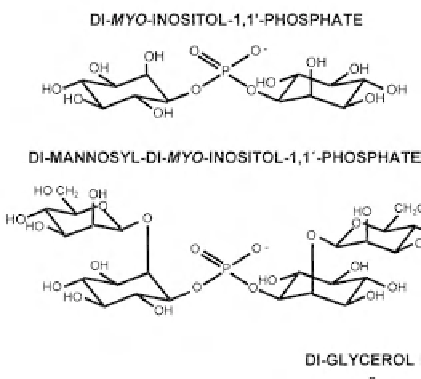Biology Reference
In-Depth Information
Figure 3:
Special osmolytes synthesized by thermophilic and hyperthermophilic prokaryotes in response to salt stress.
proteins in
A
.
torulosa
and
Anabaena
sp. strain L-31. In the former a total of 11 salt stress proteins
were induced within fi rst 10 min with another protein (of 79 kD) induced after 30 min of exposure
to 120 mM NaCl. All these proteins were found to be persistent and were synthesized at high rates
excepting one of 29 kD protein. Of these, fi ve salt stress proteins were found in the cytoplasm,
three being found in the membrane and two appearing in both the fractions. In the latter, however,
there appeared nine salt-stress proteins that were induced in the fi rst 10 min followed by another
protein after 2 h salt stress. But their synthesis appeared to be transient as only six out of the ten
proteins were continuously synthesized that were localized in the cytoplasm and two were located
in the membrane. Bhagawat and Apte (1989) presented a comparative analysis of proteins after heat
shock, salinity and osmtic stress in
Anabaena
sp. strain L-31. By the use of inhibitors of transcription
(rifampin 50 µg/ml) and translation (chloramphenicol 100 µg/ml), they identifi ed the production of
certain proteins common to all three types of stress conditions followed by the production of proteins
specifi c to each stress. In response to salt stress at least the synthesis of four proteins was repressed
with the induction or enhancement in the production of 13 other proteins of variable molecular
weights. Salt tolerance of
A
.
torulosa
and
Anabaena
sp. strain L-31 was enhanced most effectively
in presence of nitrogen sources such as nitrate, ammonium and glutamate followed by glutamine
and aspartate. Competitive inhibition by nitrate and ammonium of the Na
+
infl ux seems to be the
major mechanism for protection against salt stress (Reddy
et al
., 1989).
A
.
torulosa
and
Anabaena
sp.
strain L-31 displayed a differential response to salt and osmotic stresses. The former strain which
is halotolerant (growth inhibition by 50% in presence of 250 mM NaCl) showed a osmosensitive
behaviour (350 mM sucrose inhibited growth by 50%) where as the latter a freshwater strain that
is sensitive to salt (inhibition of growth by 50% in presence of 100 and 125 mM NaCl) exhibited
considerable osmotolerance (growth inhibition by 10 to 20% only in presence of 200 to 300 mM
sucrose). The ionic component of salt stress inhibited nitrogenase activity in both strains but not
by the osmotic stress. There was synthesis of common proteins in both of these stresses besides the
appearance of unique proteins in salt-stress and osmotic stress (Fernandes
et al
., 1993). Apte
et al
.



